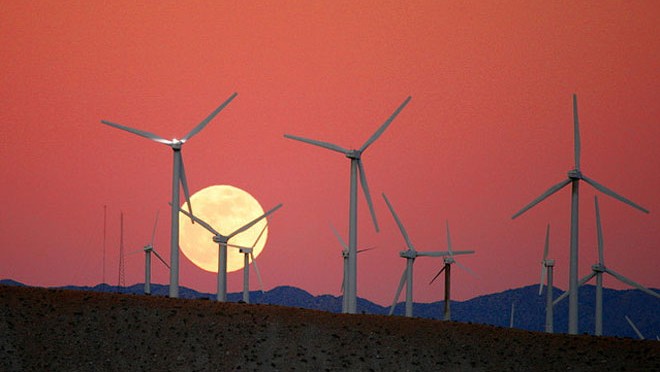Around the world, countries are investing more and more money in land-based as well as offshore wind turbines.
“What we can certainly see is a further diversification of the wind power market,” said Stefan Gsänger, secretary general for the World Wind Energy Association, a nonprofit organization based in Germany whose membership represents national wind energy associations and 100 countries. The association promotes renewable energy, advises governments on policy, and tracks wind industry developments.
These countries are based on the WWEA’s market share data as well as countries with notable wind energy leadership. Choosing just 10 was challenging — Gsänger also wanted to include Romania for its high growth rate, and Portugal with a total wind capacity just below Canada’s. Countries in Latin America and Africa are installing their first wind farms. A larger, more diverse market means increased competition and better prices for consumers.

China
China has the largest wind market size of any country, according to the WWEA. By last June, China had around 67.7 gigawatts of wind capacity from its installations. Gsänger said that number is likely closer to 80 now. Large-scale wind power development began less than 10 years ago here. Since then, the country has become an engine for the global wind industry. Wind power is necessary here, Gsänger added, because China’s conventional energy sources won’t be enough to meet its needs in the future.

USA
Looking at the World Wind Energy Association’s rankings, the United States comes in just behind China for total wind power capacity. Currently the United States has close to 60 gigawatts, Gsänger said. However the total number of installments per capita in the United States isn’t as impressive.
Political support for wind power in the United States also remains uncertain, creating challenges for manufacturers and investors seeking longer-term stability.

Germany
Germany leads the European wind market with more than 30 gigawatts, helping the EU surpass 100 gigawatts of installed wind energy last fall.
Despite its coal lobby, the country remains committed to renewable energy, Gsänger said. Wind power and other renewables have strong public support, which translates into political action. Even parties on the fence about renewable energy would run enormous political risks by coming out in opposition.

Spain
Spain’s wind power numbers say one thing, but its economy says something else. Coming in just below Germany for wind capacity, the country continues to grapple with the economic crisis that started in 2008. Austere economic conditions have reduced support for renewable energy and put additional burdens on both renewables and wind energy, Gsänger said.
Spain lacks fossil fuel resources, but there’s still a gap between potential for renewables and actual investment. “We have to see how this will develop,” Gsänger said.

India
India was one of the first developing countries to introduce large-scale wind power. A burgeoning population and high industrial growth rates have created increasing energy demands.
Without enough existing energy resources, India has been investing in renewables. While the growth of wind power is slower here than in China, “if they use their domestic resources, like wind power, that’s the big advantage,” Gsänger said.

Italy
Italian voters decided against nuclear power in a 2011 referendum. For a country otherwise dependent on fossil fuel imports, it made a lot of sense to invest in wind power, Gsänger said. Renewables have been a double-edged sword for Italy, though.
A recent sting operation revealed extensive mafia involvement in the renewable energy sector. Wiretaps caught a businessman telling a Sicilian mafia boss, “Renewable energy is important…It’s a business we can live on.” Still, Italy’s wind power capacity remains on par with that of France.

France
Last year, French president François Hollande announced plans to reduce the country’s dependence on nuclear power. Gsänger called the shift away from nuclear a big step, one that has helped France become the seventh largest wind market in the world. He remembered working for the German Wind Energy Association 10 years ago and fielding questions from the French government about the emerging wind industry. Now, French companies lead wind turbine and technology manufacturing.

Canada
Canada’s energy policies are driven by the provinces, Gsänger noted. Overall, Canada has more than 5.5 gigawatts wind power capacity. Wind power programs, particularly in Ontario and Nova Scotia, have included special incentives for community-based investors. Gsänger called that an important element in a long-term wind power strategy because it takes potential opponents and makes them drivers instead, helping them become wind farm shareholders.

Brazil
Brazil’s wind power growth has been very high, which is why it makes the list. Gsänger pointed to recent open electricity generation auctions in the country that proved wind energy could beat out gas, hydropower, nuclear, and coal on pricing given the right conditions.
Brazilian wind power was priced around 5 cents per kilowatt-hour, Gsänger said. Although observers worried that would reduce profitability, wind power complements Brazil’s hydropower production, filling the gap when the rainy season ends.

Denmark
No wind power list would be complete without mentioning Denmark. At last count, the country was getting an impressive 28 percent of its electricity from wind power and has a target to reach 50 percent by 2020. The experienced Danes know how to integrate wind power into their system, Gsänger said. In one municipality, more than 100 percent of the electricity comes from renewables and any excess goes toward heating. “It’s a cold country in wintertime, it’s a highly industrialized country, it’s a wealthy country, and still they manage that.”



